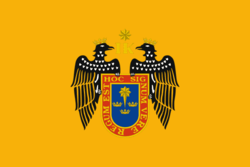Archbishop's Palace of Lima
The Archbishop's Palace of Lima, the capital of Peru, is the residence of the Archbishop of Lima, and the administrative headquarters of the Roman Catholic Archdiocese of Lima. It is located on the Plaza Mayor of Lima, in the Historic Centre of Lima.
The palace is also headquarters to the offices of the cardinal of Peru who is Juan Luis Cipriani, who is also the archbishop of Lima.
History
Located on the land that Francisco Pizarro allocated to be the residence of the head priest of Lima after the foundation of the city in 1535, the current building was opened on December 8, 1924 and is considered a prime example of neo-colonial architectural that developed in Lima during the early twentieth century.[1]
The old Archbishop's Palace was built on the place the Limean cabildo had occupied from 1535 to 1548, when that institution moved to its current location across the square. The building had six balconies of different styles and several entrances, displaying the Archdiocese coat of arms above the main gate. The architectural features of the courtyard were similar to those of several cloisters in the city. The old palace façade was demolished in the late 19th century along the Sagrario. The remaining structure was demolished prior to the construction of the present Archbishop's palace.
The current building was designed by the Polish Peruvian architect Ricardo de Jaxa Malachowski, who used the Torre Tagle Palace as a reference point. Erected joined to the Cathedral of Lima, the location formerly belonged to the city's first police station and the city's first jail. After Pope Paul III designated this temple as the primary church headquarters of the city, the location became the current location of the Archdiocese.
The facade is made up of baroque elements, completely made of reintegrated rock; ornate cedar balconies are located over the main doors, and the palace is finished by a granite sculpture of Saint Turibius of Mongrovejo the patron protector of the Archdiocese. The palace also consists of two flagpoles, one for the Peruvian flag and another for flag of the Vatican. The interior is completely ornated and is home to a sculpture of Santa Barbara the patron of Cuba. The ceiling is illuminated by famous French stained glass windows allowing the entry of light. The interior also contains marble staircases with wooden handrails which allow access to the second story.
See also
References
- ↑ (in Spanish) Arqandina, El Portal Peruano de Arquitectura, El Palacio Arzobispal
Coordinates: 12°02′46″S 77°01′47″W / 12.0462°S 77.0296°W
